Clarach has laid an egg.
At 17:25 yesterday, 4th May 2017, Clarach laid her first ever egg on her new nest at Aberfoyle, Scotland, 250 miles directly north as the osprey flies from her natal Dyfi nest.
Clarach has laid an egg.
At 17:25 yesterday, 4th May 2017, Clarach laid her first ever egg on her new nest at Aberfoyle, Scotland, 250 miles directly north as the osprey flies from her natal Dyfi nest.
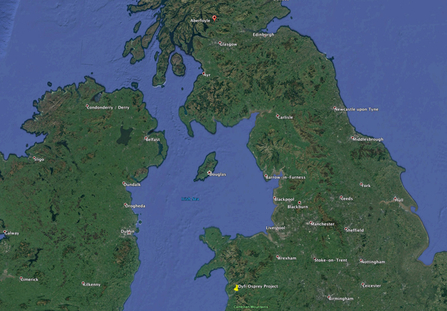
Clarach is a 2013 offspring and Glesni's first-born. She had a sister in the same clutch as her, called Cerist.
Many of you will remember the sad start to the 2013 season when Nora failed to return and it looked for a long time as if Monty would not be breeding that year. Many females came and went, but then, at the start of May, Blue 12 arrived; a three-year-old Rutland female that was determined to have Monty for herself.
Monty chases Blue 12 off his nest early on in May, 2013
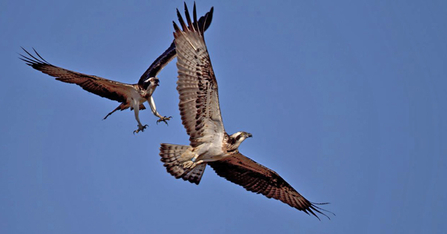
Monty (left), Glesni. © MWT
Not too keen at the start, Monty eventually took to Blue 12 - whom we named Glesni. We thought the breeding window had passed, but amazingly Glesni laid an egg very late on in the season on 22nd May. That egg was, of course, Clarach.
Fast forward four years and now Clarach is emulating her Mum at a nest in the beautiful Loch Lomond & The Trossachs National Park. She has over 30 osprey nests around her in an established population - the girl has chosen well.
Glesni's first ever egg - 22nd May 2013. This was Clarach's egg.
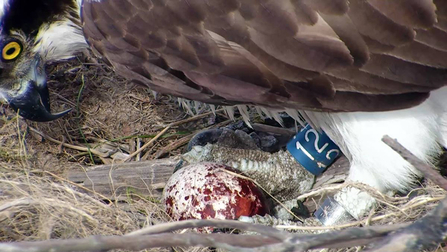
Clarach grew strong and healthy and fledged the Dyfi nest on 18th August at 52 days old. She became a strong and confident flier.
Before & After: Clarach's transformation in less than eight weeks
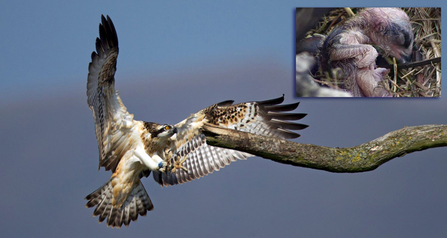
Clarach. © MWT
Stardom
Clarach was first spotted back in the UK last year as a three-year-old, first at the Glaslyn nest, then Rutland, then Kielder - all nests with cameras. Now she's at another nest with a camera at Aberfoyle - what are the odds of that happening!!
Clarach and her new man at Aberfoyle
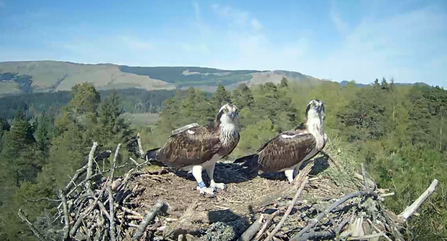
Clarach (left), unringed male. © Forestry Commission Scotland
What we don't know, of course, is how many other nests has she landed on that don't have a camera. Only around 5% of the UK osprey nests have cameras fitted, so the chances of her landing only on nests with cameras are astronomical. We can actually work it out for the five nests that we know of - it's around 160,000 to 1.
So the chances are, she has also landed and prospected for a male and nest site at other eyries. But there might be a little bit of ecological reasoning here as well...
Clarach grew up for the first three months of her life with four cameras a few feet from her nest. She will have habituated to her surroundings, including the trains passing her nest, the suite of cameras, and Alwyn shouting "INTRIWWDARRR" every two hours.
Maybe Clarach sees nest cameras as a normal part of a nest that she has imprinted on from an early age? After all, all the other nests with cameras installed that she has visited had successful breeding ospreys on them.
Clarach and Cerist grew up in 2013 surrounded by cameras
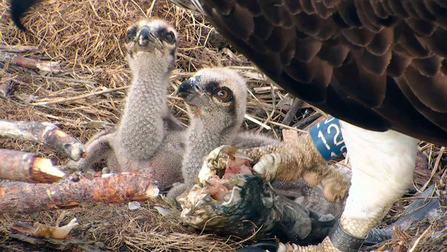
Clarach, Cerist. © MWT
Surprise
Many of us were caught out a bit last night when Clarach suddenly laid her egg.
Sure, she had been settling down on this nest for 16 days (since 14th April), but there seemed to me more than one male around, including a Scottish ringed chap. We couldn't see what was happening off camera obviously, and when the camera was switched off, but there didn't seem to be the usual nest building, fish sharing and mating - until the start of this week when things started to look a lot more congruent with two (possibly inexperienced) young ospreys pair bonding.
Clarach and her new male friend 'pair bonding'!
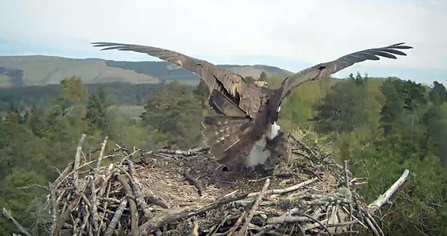
© Forestry Commission Scotland
The male at this nest is unringed, so we don't know his age or where he is from. As a speculative guess however, I would think he is a Scottish male (only around half are ringed in Scotland) and probably from a nest not too far away. He looks a bit inexperienced too - maybe he is only three or four years old?
4th May - Clarach lays her first ever egg
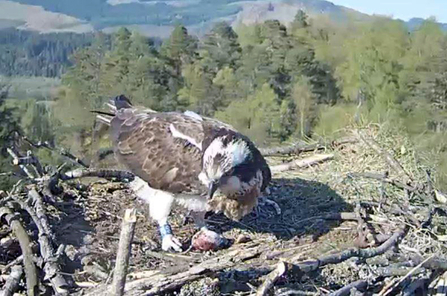
Clarach. © Forestry Commission Scotland
Eggspecting More?
So Clarach laid her egg on DAY 16, maybe 17, after first meeting up with her new male - this is bang on the timeline you would eggspect. She is due to lay her second egg sometime during Sunday afternoon, 7th May.
But before we get carried away, we have to be a bit cautious here. It's her first time, the male is possibly inexperienced and we have not seen many of the usual pair-bonding interactions until fairly recently. Let's just hope for now that everything works out for these two birds. Even if they managed to raise one chick this year, that would be a great achievement for two birds that have (almost certainly) not bred before.
Thank You
This Aberfoyle nest is managed by Forestry Commission Scotland and the lovely Nik Cox sends us regular messages and updates.
They have done a wonderful job in making the camera available for all of us to watch via Live Streaming - not an easy task in the middle of a forest miles away from mains-power and other equipment.
A massive thank you to all of you up there, you are to be commended and congratulated on your success. You have made a few thousand people giddy with happiness - the very best of luck to you all for the rest of the season.
You can view Clarach on Forestry Commission Scotland's webcam.
Protection volunteers have a thankless task. Early mornings, night shifts, matchstick eyes, all to prevent an egg or three being stolen or disturbed. And all unpaid.
For eight weeks of the year our Protection volunteers help us watch over the Dyfi nest and their reward is sometimes difficult to see or visualise. If they do their job correctly, everything runs smoothly and nothing happens to the eggs.
Scanning and surveillance

Five Glaslyn offspring have returned to the UK and bred for themselves to date. Clarach is the first bird from any of the other three Welsh nests that we know of to have done the same. This is a milestone in the progress of osprey conservation in Wales and for the first time, those long-suffering volunteers can see the fruits of their hard work.
Thank you for all your dedication guys. Success in conservation can take time, but when it comes, it's a magical feeling. This is your reward, your legacy, and as the Americans say - this is pay dirt. Many, many congratulations.
Clarach shortly before she left the Dyfi for her first migration south in September 2013
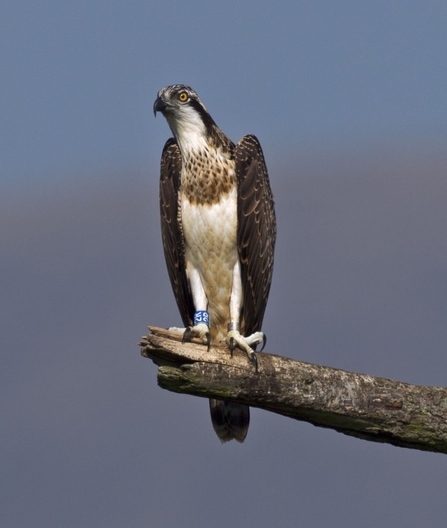
Clarach. © MWT
UPDATE: 7th May CLARACH HAS LAID EGG NO 2 at 14:20 !!
When a female osprey receives several reproductive cues at once, especially for her first ever breeding year, she may lay an egg. A kind of hormone egg that may or may not be fertilised.
When a female lays a second egg around 70 hours after the first, it means that these reproductive cues are strong, repetitive and consistent. In other words, a male is catching fish for her, defending the nest, bringing in nesting material and, of course, mating.
This egg is at the early end of the time window it takes a female to produce an egg - it means that she would have started to produce it immediately after laying the first.
These are good signs that she is in full breeding mode and is not just plopping out eggs like a Bingo machine.
All of us at DOP are utterly delighted, we're sure you are too
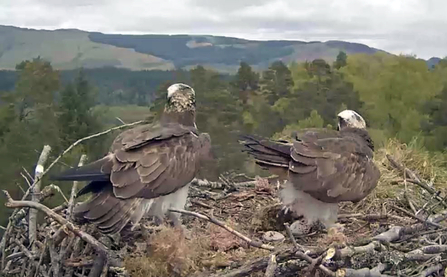
© Forestry Commission Scotland
UPDATE: 10th May CLARACH HAS LAID EGG NO 3
Clarach laid her third egg this morning, time unknown. Possibly just before the cameras were switched on at 09:30.